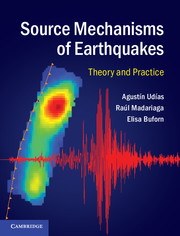Book contents
- Frontmatter
- Contents
- Preface
- Chapter 1 Earthquakes and fault motion
- Chapter 2 Processing and analysis of recorded seismic signals
- Chapter 3 Mathematical representation of the source
- Chapter 4 Point source models
- Chapter 5 The seismic moment tensor
- Chapter 6 Determination of point source mechanisms
- Chapter 7 Kinematics of extended sources
- Chapter 8 Determination of source dimensions
- Chapter 9 Simple dynamic models
- Chapter 10 Dynamics of fracture. Homogeneous models
- Chapter 11 Fracture dynamics. Heterogeneous models
- Chapter 12 Modeling earthquakes using fracture dynamics
- References
- Index
Chapter 9 - Simple dynamic models
Published online by Cambridge University Press: 05 June 2014
- Frontmatter
- Contents
- Preface
- Chapter 1 Earthquakes and fault motion
- Chapter 2 Processing and analysis of recorded seismic signals
- Chapter 3 Mathematical representation of the source
- Chapter 4 Point source models
- Chapter 5 The seismic moment tensor
- Chapter 6 Determination of point source mechanisms
- Chapter 7 Kinematics of extended sources
- Chapter 8 Determination of source dimensions
- Chapter 9 Simple dynamic models
- Chapter 10 Dynamics of fracture. Homogeneous models
- Chapter 11 Fracture dynamics. Heterogeneous models
- Chapter 12 Modeling earthquakes using fracture dynamics
- References
- Index
Summary
Kinematic and dynamic models
Kinematic models for the source of earthquakes, the type of model that we have considered up to this point, describe the time-dependent distribution of the slip Δui(t) on a fault and are a simplified representation of the real fracture process. In kinematic models the rupture propagates at a constant or variable speed and is made to stop at the fault limits. A number of arbitrary factors are introduced into these models, some of which lead to physical inconsistencies at, for example, the borders of the fault. In spite of these limitations, kinematic models provide essential information about the seismic source, such as the fault orientation, source dimensions and slip distribution on the fault plane. However, the physical occurrence of an earthquake provides a dynamic problem: the slip on the fault has to be considered as a consequence of the stress conditions and the strength of the material in the focal region. Dynamic models of the generation of earthquakes take into consideration these conditions and are based on the theory of the generation and propagation of fractures or cracks in stressed media. From this point of view, the mechanism of tectonic earthquakes may be represented by a shear fracture produced when the stress acting overcomes the strength of the material and/or the friction between the two sides of a pre-existing fault. A fracture initiates at a point of the fault where the stress acting on the fault plane exceeds a critical value, then it propagates with a certain rupture velocity and finally stops when the mechanical conditions impede its further propagation. A complete dynamic model must, then, include the whole fracture process, that is, its initiation or nucleation, propagation and arrest, and must be derived from the stress conditions and the properties of the material in the focal region. The two determining factors are the stresses acting on the focal region due to tectonic processes derived from the motion of lithospheric plates and the mechanical properties of the rocks in the region. Since seismic fractures generally take place on pre-existing faults, important factors are the conditions between the two sides of the fault, mainly friction.
- Type
- Chapter
- Information
- Source Mechanisms of EarthquakesTheory and Practice, pp. 189 - 204Publisher: Cambridge University PressPrint publication year: 2014



